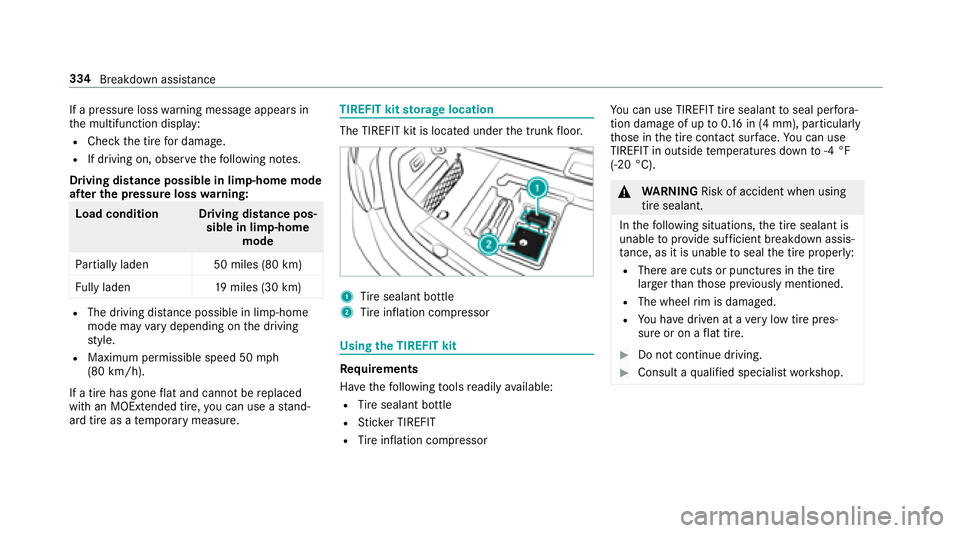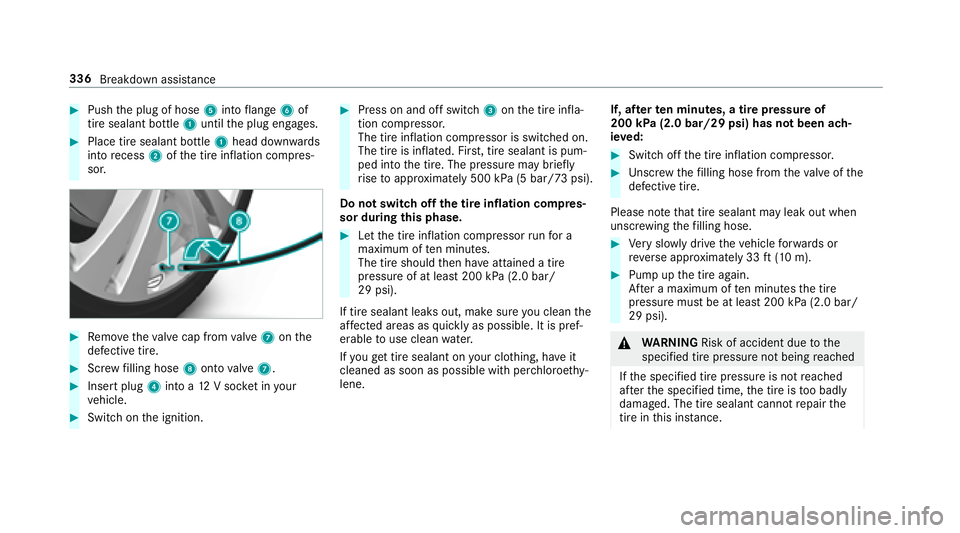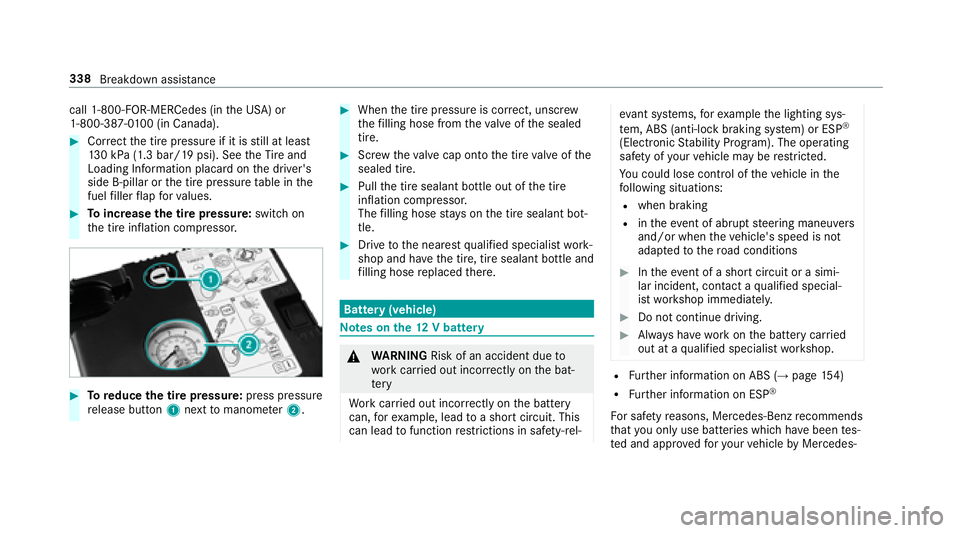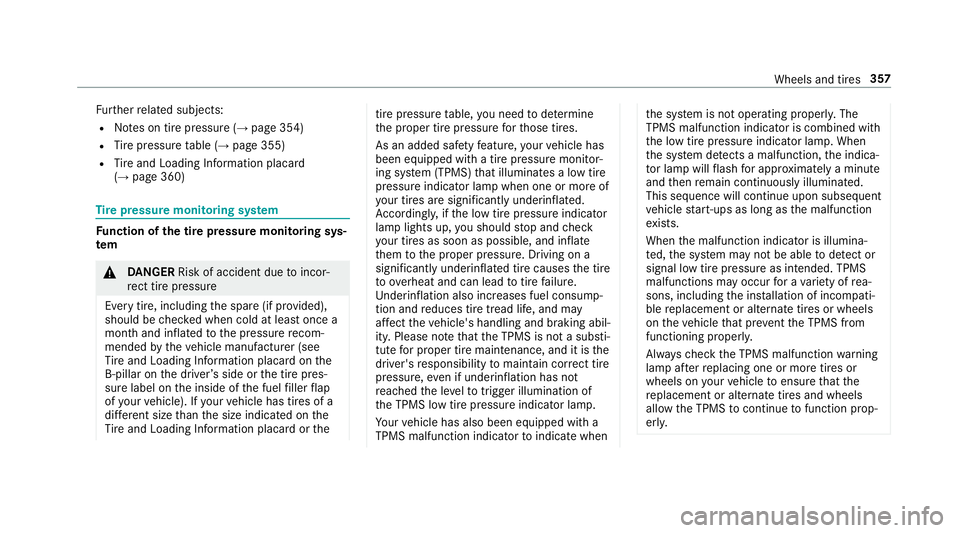inflation pressure MERCEDES-BENZ E-CLASS CABRIOLET 2018 Owner's Manual
[x] Cancel search | Manufacturer: MERCEDES-BENZ, Model Year: 2018, Model line: E-CLASS CABRIOLET, Model: MERCEDES-BENZ E-CLASS CABRIOLET 2018Pages: 498, PDF Size: 6.28 MB
Page 336 of 498

If a pressure losswarning message appears in
th e multifunction display:
RCheck the tire for dama ge.
RIf driving on, obser vethefo llowing no tes.
Driving distance possible in limp-home mode
af te r the pressure loss warning:
Load condition Driving distance pos‐
sible in limp-homemode
Pa rtially laden 50 miles (80 km)
Fu lly laden 19miles (30 km)
RThe driving dis tance possible in li mp-home
mode may vary depending on the driving
st yle.
RMaximum permissible speed 50 mph
(80 km/h).
If a tire has gone flat and cannot be replaced
with an MOEx tended tire, you can use a stand‐
ard tire as a temp orary measure.
TIREFIT kit storage location
The TIREFIT kit is located under the trunk floor.
1Ti re sealant bottle
2Tire inflation compressor
Using the TIREFIT kit
Re quirements
Ha ve thefo llowing tools readily available:
RTire sealant bottle
RSticke r TIREFIT
RTire inflation compressor Yo
u can use TIREFIT tire sealant toseal per fora ‐
tion damage of upto0.16 in (4 mm), particularly
th ose in the tire conta ct surface.You can use
TIRE FIT in outside temp eratures down to-4 °F
(-20 °C).
0071 WARNING Risk of accident when using
tire sealant.
In thefo llowing situations, the tire sealant is
unable toprov ide suf ficient breakdown assis‐
ta nce, as it is unable toseal the tire properly:
RThere are cuts or punctures in the tire
lar gerth an those pr eviously mentioned.
RThe wheel rim is dama ged.
RYo u ha vedriven at a very low tire pres‐
sure or on a flat tire.
00BBDo not continue driving.
00BBConsult a qualified specialist workshop.
334
Breakdown assis tance
Page 338 of 498

00BBPushthe plug of hose 5into flange 6of
tire sealant bottle 1until the plug engages.
00BBPlace tire sealant bottle 1head down wards
into recess 2ofthe tire inflation compres‐
sor.
00BBRe mo vetheva lve cap from valve 7 onthe
defective tire.
00BBScr ew filling hose 8onto valve 7.
00BBInsert plug 4into a 12V soc ket in your
ve hicle.
00BBSwitch on the ignition.
00BBPress on and off switch 3onthe tire infla‐
tion compressor.
The tire inflation compressor is switched on.
The tire is inflated. Fir st, tire sealant is pum‐
ped into the tire. The pressure may brief ly
ri se toappr oximately 500 kPa (5 bar/73 psi).
Do not switch off the tire inflation compres‐
sor du ring this phase.
00BBLet the tire inflation compressor runfo r a
maximum of ten minu tes.
The tire should then ha veattained a tire
pressure of at least 200 kPa (2.0 bar/
29 psi).
If tire sealant leaks out, make sure you clean the
af fected areas as quickly as possible. It is pref‐
erable touse clean water.
If yo uge t tire sealant on your clo thing, ha veit
cleaned as soon as possible with per chloroe thy‐
lene. If, af
terte n minutes, a tire pressure of
200 kPa (2.0 bar/29 psi) has not been ach‐
ie ve d:
00BBSwitch off the tire inflation compressor.
00BBUn scr ew thefilling hose from theva lve of the
defective tire.
Please no tethat tire sealant may leak out when
unscr ewing thefilling hose.
00BBVe ry slowly drive theve hicle forw ards or
re ve rse appr oximately 33 ft(10 m).
00BBPump up the tire again.
Af ter a maximum of ten minu testh e tire
pressure must be at least 200 kPa (2.0 bar/
29 psi).
0071 WARNING Risk of accident due tothe
specified tire pressure not being reached
If th e specified tire pressure is not reached
af te rth e specified time, the tire is too badly
damaged. The tire sealant cannot repair the
tire in this ins tance.
336
Breakdown assist ance
Page 339 of 498

Damaged tires and a tire pressurethat is too
low can significantly impair braking and han‐
dling characteristics.
00BBDo not continue driving.
00BBConsult a qualified specialist workshop.
If, af terte n minutes, a tire pressure of
200 kPa (2.0 bar/29 psi) has been achie ved:
0071
WARNING Risk of accident from driving
wi th sealed tires
A tire temp orarily sealed with tire sealant
impairs the handling characteristics and is
not suitable for higher speeds.
00BBAd apt your dr ivingst yle according lyand
drive carefull y.
00BBDo notexceed the specified maximum
speed with a tire that has been repaired
using tire sealant.
00BBObser vethe maximum permissible speed for
a tire sealed with tire sealant 50 mph
(80 km/h).
00BBFa sten the upper section of the TIREFIT
st icke rto the instrument clus ter where it will
be easi lyseen bythe driver.
0075 NO
TEStaining caused byleaking tire
sealant
Af ter use, excess tire sealant may leak out
from thefilling hose.
00BBTherefore, place thefilling hose in the
plastic bag that con tained the TIREFIT
kit.
00D2ENVIRONMEN TALNO TEEnvironmental
pollution caused byenvironmen tally ir re‐
sponsible disposal
Ti re sealant contains polluta nts.
00BBHave the tire sealant bottle disposed of
professionall y,e.g. at an authorized
Mercedes-Benz Center.
00BBSwitch off the tire inflation compressor.
00BBUn scr ew thefilling hose from theva lve of the
defective tire.
00BBSt ore the tire sealant bottle and the tire infla‐
tion compressor.
00BBPull away immediatel y.
00BBStop af ter driving for app roxima tely ten
minutes and check the tire pressure using
th e tire inflation compressor.
The tire pressure must now be at least
13 0 kPa (1.3 bar/19 psi).
0071
WARNING Risk of accident due tothe
specified tire pressure not being reached
If th e specified tire pressure is not reached
af te r a brief drive, the tire is too badly dam‐
aged. The tire sealant cannot repair the tire
in this ins tance.
Dama ged tires and tire pressure that is too
low can significantly impair the braking prop‐
erties and the handling characteristics.
00BBDo not continue driving.
00BBConsult a qualified specialist workshop.
In cases such as the one mentioned abo ve, con‐
ta ct an au thorized Mercedes-Benz Center. Or
Breakdown assis tance 337
Page 340 of 498

call 1-800-FOR-MERCedes (inthe USA) or
1-800-387-0 100 (in Canada).
00BBCor rect the tire pressure if it is still at least
13 0 kPa (1.3 bar/19 psi). See theTire and
Loading Info rmation placard on the driver's
side B‑pillar or the tire pressure table in the
fuel filler flap forva lues.
00BBTo increase the tire pressure: switchon
th e tire inflation compressor.
00BBTo reduce the tire pressure: press pressure
re lease button 1next tomanome ter2.
00BBWhen the tire pressure is cor rect, unscr ew
th efilling hose from theva lve of the sealed
tire.
00BBScr ew theva lve cap onto the tire valve of the
sealed tire.
00BBPull the tire sealant bottle out of the tire
inflation compressor.
The filling hose stay s on the tire sealant bot‐
tle.
00BBDrive tothe nearest qualified specialist work‐
shop and ha vethe tire, tire sealant bottle and
fi lling hose replaced there.
Bat tery (vehicle)
Note s onthe12 V battery
0071
WARNING Risk of an accident due to
wo rkcar ried out incor rectly on the bat‐
te ry
Wo rkcar ried out incor rectly on the battery
can, forex ample, lead toa short circuit. This
can lead tofunction restrictions in saf ety-re l‐
eva nt sy stems, forex ample the lighting sys‐
te m, ABS (anti-lock braking system) or ESP®
(Elect ronic Stability Prog ram). The operating
saf etyof your vehicle may be restricted.
Yo u could lose cont rol of theve hicle in the
fo llowing situations:
Rwhen braking
Rin theeve nt of ab rupt steering maneuvers
and/or when theve hicle's speed is not
adap tedto thero ad conditions
00BBIn theeve nt of a short circuit or a simi‐
lar incident, contact a qualified special‐
ist workshop immediately.
00BBDo not continue driving.
00BBAlw ays ha vewo rkon the battery car ried
out at a qualified specialist workshop.
RFu rther information on ABS (→page 154)
RFurther information on ESP®
Fo r saf etyre asons, Mercedes-Benz recommends
th at you only use batte ries which ha vebeen tes‐
te d and appr oved foryo ur vehicle byMercedes-
338
Breakdown assis tance
Page 359 of 498

Further related subjects:
RNo tes on tire pressure (→page 354)
RTire pressure table (→page 355)
RTire and Loading Info rmation placard
(→page 360)
Ti re pressure moni toring sy stem
Fu nction of the tire pressure moni toring sys‐
te m
0071
DANG ER Risk of accident due toincor‐
re ct tire pressure
Every tire, including the spare (if pr ovided),
should be checked when cold at least once a
month and inflated tothe pressure recom‐
mended bytheve hicle manufacturer (see
Ti re and Loading Info rmation placard on the
B-pillar on the driver ’sside or the tire pres‐
sure label on the inside of the fuel filler flap
of your vehicle). If your vehicle has tires of a
dif fere nt size than the size indicated on the
Ti re and Loading Info rmation placard or the
tire pressure table, you need todeterm ine
th e proper tire pressure forth ose tires.
As an added saf etyfe ature, your vehicle has
been equipped with a tire pressure monitor‐
ing sy stem (TPMS) that illuminates a low tire
pressure indicator lamp when one or more of
yo ur tires are signif icantly underinflated.
Ac cording ly, if the low tire pressure indicator
lamp lights up, you should stop and check
yo ur tires as soon as possible, and inflate
th em tothe proper pressure. Driving on a
significant lyunderinflated tire causes the tire
to ov erheat and can lead totire failure.
Un derinflation also increases fuel consump‐
tion and reduces tire tread life, and may
af fect theve hicle's handling and braking abil‐
ity. Please no tethat the TPMS is not a substi‐
tute for proper tire maintenance, and it is the
driver's responsibility tomaintain cor rect tire
pressure, even if underinflation has not
re ached the le velto trig ger illumination of
th e TPMS low tire pressure indicator lamp.
Yo ur vehicle has also been equipped with a
TPMS malfunction indicator toindicate whenthe sy stem is not operating proper ly. The
TPMS malfunction indica tor is combined with
th e low tire pressure indicator lamp. When
th e sy stem de tects a malfunction, the indica‐
to r lamp will flash for app roxima tely a minute
and then remain continuously illumina ted.
This sequence will continue upon subsequent
ve hicle start-ups as long as the malfunction
ex ists.
When the malfunction indicator is illumina‐
te d, the sy stem may not be able todetect or
signal low tire pressure as intended. TPMS
malfunctions may occur for a variet yof rea‐
sons, including the ins tallation of incompati‐
ble replacement or alternate tires or wheels
on theve hicle that pr eventthe TPMS from
functioning properly.
Alw aysch eck the TPMS malfunction warning
lamp af terre placing one or more tires or
wheels on your vehicle toensure that the
re placement or alternate tires and wheels
allow the TPMS tocontinue tofunction prop‐
erly.
Wheels and tires 357
Page 492 of 498

TimeManual time setting ............................. 232
Setting summer time ........................... 232
Setting the time and date automati‐
cally ..................................................... 232
Setting the time zone .......................... 232
Setting the time/date form at .............. 232
TIN (Tire Identification Number) ............3 66
Ti re and Loading Information placard ... 360
Ti re ch aracteristics ................................. 368
Ti re inflation compressor
see TIREFIT kit
Ti re information table .............................360
Ti re labeling ............................................ .365
Cha racteristics .................................... 368
DO T,Tire Identification Number (TIN)
.............................................................3 66
Load index ...........................................3 68
Load-beari ng capacity ......................... 368
Maximum tire load ............................... 367
Maximum tire pressure ........................ 367
Overview ............................................. 365
Speed rating ........................................ 368
Te mp erature grade .............................. 365 Ti
re Quality Grading ............................. 365
Ti re size designation ............................3 68
Tr action grade .................................... .365
Tr ead wear grade ................................ .365
Ti re load (maximum) .............
.................
.367
Ti re pressure ........................................... 356
Checking (manually) ............................ 356
Checking (tire pressure monito ring
sy stem) ............................................... 358
Maximum ............................................. 367
No tes ................................................... 354
Re starting the tire pressure loss
wa rning sy stem ................................... 360
Re starting the tire pressure monitor‐
ing sy stem .......................................... .359
Ti re pressure loss warning sy stem
(function) ............................................. 359
Ti re pressure monitoring sy stem
(function) ............................................. 357
Ti re pressure table .............................. 355
TIREFIT kit ...........................................3 34
Ti re pressure loss warning sy stem
Fu nction .............................................. 359
Re starting ............................................ 360 Ti
re pressure moni toring sy stem
Checking the tire pressures ............... .358
Che cking the tire temp erature ............ 358
Fu nction .............................................. 357
Re starting .............................. .............. 359
Te ch nical da ta..................................... 359
Tire pressure table .................................. 355
Tire Quality Grading ................................ 365
Tire temp erature
Checking (tire pressure monitoring
sy stem) ............................................... 358
Ti re pressure monitoring sy stem
(function) ............................................. 357
Ti re tread ................................................. 352
Tire-change tool kit
Overview .............................................. 376
TIREFIT kit ................................................ 334
St orage location ..................................3 34
Using ................................................... 334
Ti re s
Changing hub caps .............................. 377
Characteristics .................................... 368
Checking ............................................ .352
490
Index